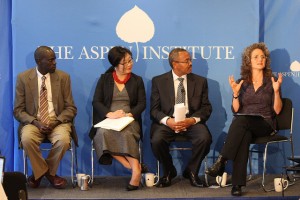The 7 Billion Conversation: Addressing Water Scarcity Challenges
Apr 25th, 2012 | By admin | Category: Family PlanningBy Suzanne York, HowMany.org, April 25, 2012
The Aspen Institute continued its series exploring living in a world of 7 billion people with an event this past April 18th, in a session called “A Long Walk to Water: Women, Population and Access to Safe Water.” As society grapples with a population projected to hit over 9 billion by 2050, how we handle water resources is perhaps the most critical issue facing the world.
Here are just a few facts on water to bear in mind:
-
approximately 2 billion people currently live in areas of water scarcity, and by 2025, 2 out of 3 people will live in situations of water stress;
-
less than 1 percent of the world’s water can be used for human needs;
-
the U.S. National Intelligence Estimate predicts that from 2022 and beyond, it will become more likely that water will become a weapon of war or tool of terrorism, especially in South Asia, the Middle East, and North Africa;
-
of the 45 most water-stressed countries in the world, 35 of them are in Africa, according to the World Bank;
-
the most water-stressed regions are usually those with few water resources, high population densities, and high population growth rates.
Last year, for the first time the World Economic Forum listed water as one of the top five global risks in its Global Risk Report. It concluded that rapid population growth and increasing prosperity “are putting unsustainable pressure on resources.” Furthermore, demand for water, food, and energy is expected to increase 30 percent to 50 percent in the next 20 years.
These impending crises framed the Aspen Institute seminar and discussion framed around water becoming the “oil war of the future”. Two of the speakers were from Africa and have first-hand experience in facing water scarcity. Salva Dut is a former “lost boy of Sudan” who returned to his newly created country of South Sudan and formed the organization Water for South Sudan (WSS) after his father became ill from water borne diseases. WSS drills wells and has built 130 wells across many villages. They train the villagers in maintaining the wells (and provide them parts), a crucial component often overlooked in past development efforts.
Dut believes Sudan is experiencing water wars now. The latest headlines from the region report that the conflict between Sudan and South Sudan is intensifying, with access to water surely a part of that. Dut’s story is moving, and he understands that any solution to water scarcity goes beyond drilling wells; women must be put front and center and be given access to education and a means out of poverty. WSS ensures that women are trained in taking care of the wells. “Women are the engine,” Dut said.
Shewaya Deribe Woldeyohannes is an Ethiopian specialist in wetlands and biodiversity and promotes integration of population, health, and environment (PHE) projects. He too thinks it is inevitable that water wars will come. He has already seen how his country’s growing population and demand for water is stressing the environment, from soil erosion to drought to food insecurity. Woldeyohannes works with Ethio-Wetlands and Natural Resource Association to protect Ethiopia’s wetlands and biodiversity. The solution, he believes, lies in integrating watershed management, family planning/health, and livelihoods. Protecting only the wetlands, biodiversity and water sources alone wasn’t working; “we have to focus on the human element”, or impact. He emphasized the need to educate and empower women, and for increased investment in PHE programs so all “people can live better lives.”
Also part of the conversation was population justice advocate and writer Laurie Mazur, whose work focuses on not only population and reproductive health, but on the need to distribute resources in an equitable manner. She noted that areas of water scarcity are places with the greatest unmet need for family planning and reproductive health services. Beyond being a matter of public health and social justice, addressing this unmet need would slow population growth and, according to Mazur, “reduce the scale of water supply challenges and give countries some breathing room, and the time and resources to come up with creative solutions.”
Giving women the means and power to make their own decisions about family planning is critical. And even when cultural factors seem an overwhelming obstacle, Mazur reminded the audience that cultures do change and “can do so with lightening speed.” She cited as an example the drop in fertility rates in countries after the introduction of family planning services.
Jaehyang So, a water and sanitation expert with the World Bank, rounded out the excellent panel. “How we manage water and get it to the right people is key,” she said, and in a world where 2.5 billion people don’t have access to sanitation there is incredible need to “massively scale up access.” Some of the answers include exploiting innovation and building partnerships to ensure that “water gets to the right people at the right times”.
Despite the difficulties of the water issues confronting the world, all the speakers left the audience with a sense of hope. Yes, we have to do more, but we are already undertaking initiatives that are working. We just need to use critical resources like water more efficiently and equitably, and share best practices. Most importantly, involve women, as they understand the value of water. And by empowering women and prioritizing family planning, we can create solutions that will help us positively meet our challenges.
Suzanne York is a senior writer with the Institute for Population Studies/HowMany.org

